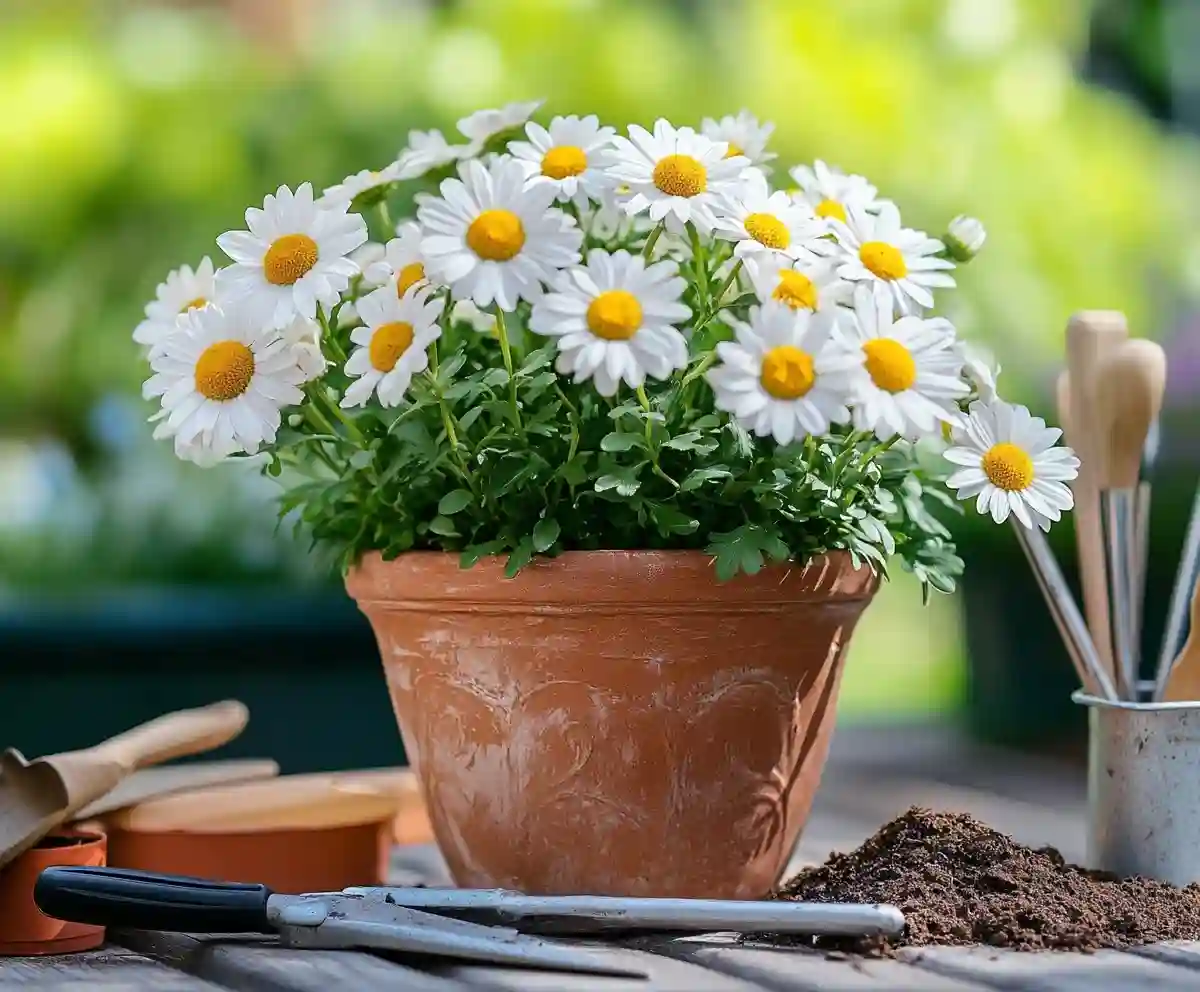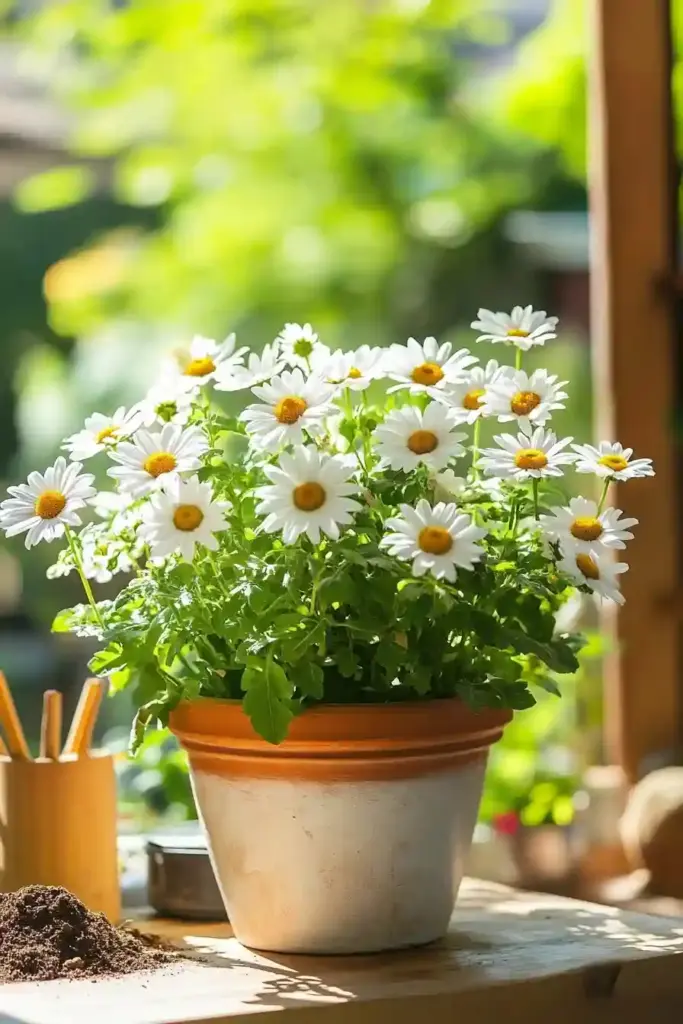Daisies are the kind of flowers that instantly bring a smile. With their sunny yellow centers and bright white (or sometimes pink, red, or purple) petals, they’re not just beautiful — they’re easy to grow, too. Whether you’re planting a few in a border or filling a whole bed, learning how to grow and care for daisies will reward you with long-lasting blooms and very little fuss.
These cheerful perennials thrive with minimal care, making them ideal for beginner gardeners and seasoned green thumbs alike. With the right planting spot, a bit of sunshine, and some basic upkeep, your daisy patch can flourish for years.
Let’s start by getting to know the different types of daisies you might want to grow.
🌸 Popular Varieties of Daisies for Your Garden
Daisies belong to the Asteraceae family — a massive plant family that also includes marigolds, sunflowers, and zinnias. While the classic image is the white-petaled daisy with a golden center, there’s actually a vibrant world of daisy varieties out there. Here are some of the most garden-friendly favorites:
1. Shasta Daisy (Leucanthemum × superbum)
- Bright white petals with bold yellow centers
- Tall stems and bushy growth habit
- Blooms from early summer to fall
- Deer- and drought-tolerant once established
2. Oxeye Daisy (Leucanthemum vulgare)
- Similar to Shasta, but smaller and more wild-looking
- Known for spreading easily — great for naturalized areas
- Considered invasive in some regions, so check local guidelines
3. Gerbera Daisy (Gerbera jamesonii)
- Large, vivid blooms in red, pink, orange, and yellow
- Often grown as annuals or houseplants in cooler climates
- Great for cutting gardens and containers
4. Painted Daisy (Tanacetum coccineum)
- Feathery foliage with daisy-like flowers in pink, magenta, and white
- Naturally repels certain garden pests
- Prefers full sun and well-drained soil
5. Montauk Daisy (Nipponanthemum nipponicum)
- Late-blooming variety, often flowering into early frost
- Thick, leathery leaves that tolerate salt and wind — perfect for coastal gardens
💡 Pro Tip: Before planting, check with your local extension office or native plant society to ensure the variety you choose is suited to your region and not invasive.
🌞 How to Care for Daisies: Light, Soil, Water & More
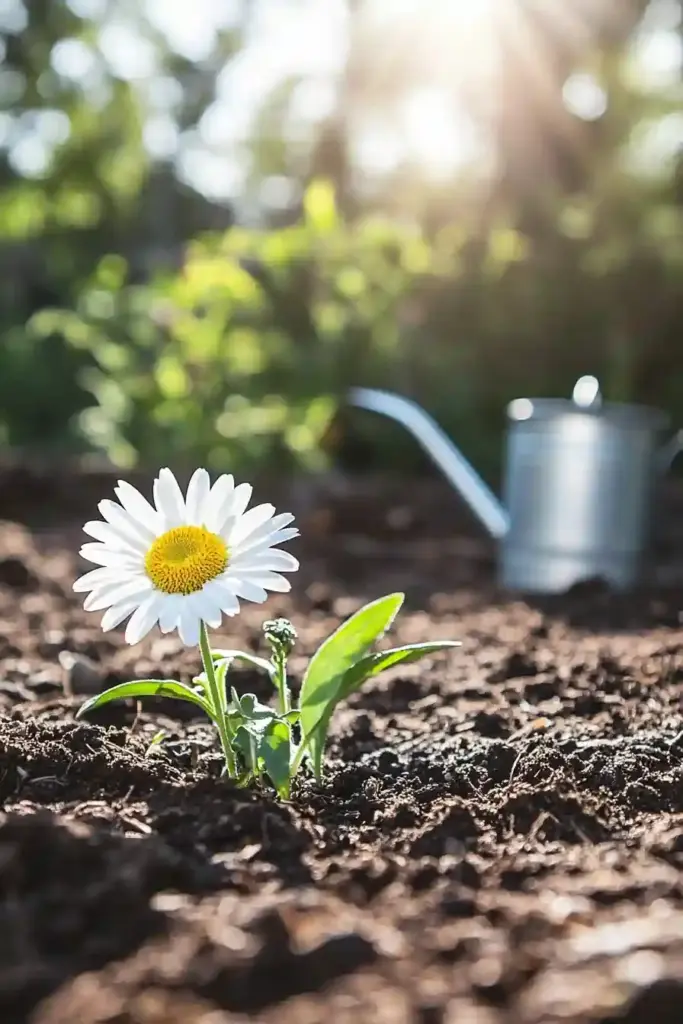
Once your daisies are in the ground (or a pot), it doesn’t take much to keep them happy. These hardy flowers are known for their resilience, but like any plant, they’ll bloom best when their basic needs are met. Here’s how to give your daisies the VIP treatment they deserve.
☀️ Sunlight: Daisies Love the Spotlight
Daisies are sun worshippers. For the most vibrant blooms, plant them in a spot that receives at least 6 hours of full sunlight daily. While some varieties can tolerate partial shade, they won’t flower as heavily.
Quick Tip: If your daisies look leggy or produce fewer blooms, they might be craving more sunshine.
🌱 Soil Requirements: Keep It Loose and Well-Drained
One thing daisies don’t like? Wet feet.
These plants prefer well-draining soil — think sandy loam or amended garden soil that doesn’t stay soggy. If your garden tends to hold moisture, consider raising the bed or mixing in compost and perlite to improve drainage.
Ideal soil pH: Slightly acidic to neutral (6.0–7.0)
💧 Watering: Don’t Overdo It
While daisies are fairly drought-tolerant once established, they’ll appreciate regular watering, especially during hot spells.
- During the growing season: Water once a week with 1–2 inches of water at the base.
- In cooler months: Cut back to every other week.
- Signs they need water: Wilted leaves or drooping blooms — they’re not shy about showing thirst!
🚫 Avoid overhead watering, which can lead to fungal diseases.
🌿 Fertilizer: Feed Gently for Stronger Blooms
Daisies aren’t heavy feeders, but a little nutrition goes a long way.
- Option 1: Apply a balanced, slow-release fertilizer (like 10-10-10) once a month during spring and summer.
- Option 2 (organic gardeners): Mulch with compost or well-rotted manure to boost soil nutrients gradually.
Too much fertilizer can lead to more foliage and fewer flowers, so don’t overdo it!
🌱 How to Grow Daisies from Seed (and Plant Them Like a Pro)
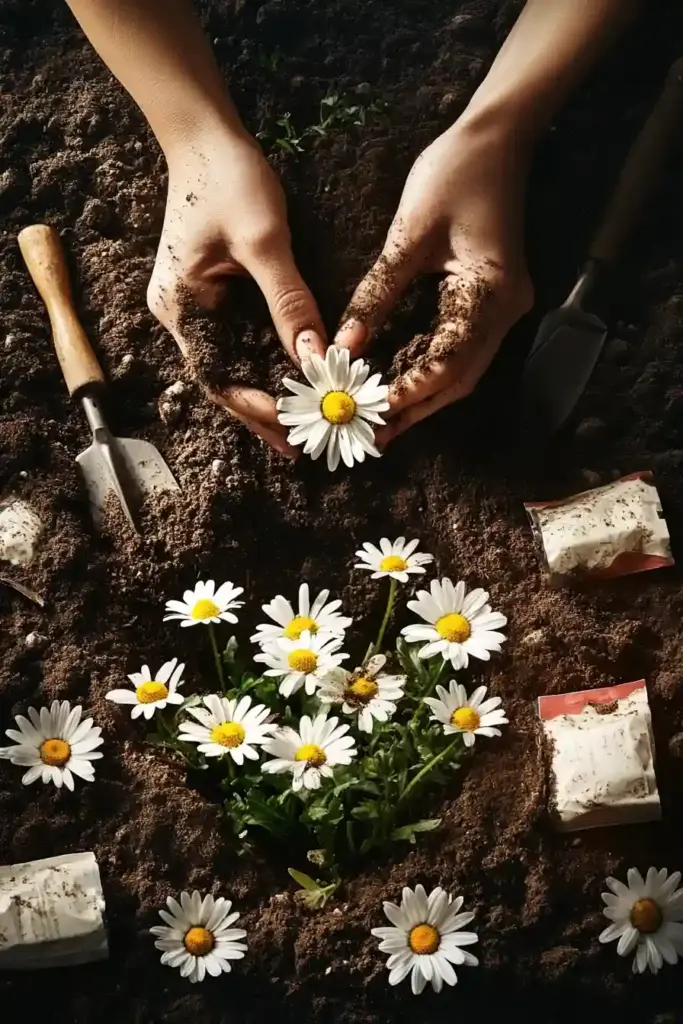
Whether you’re starting from seed or picking up young plants from the nursery, daisies are surprisingly easy to grow. With just a little planning, you can enjoy cheerful blooms that return year after year.
🧤 Starting Daisies from Seed
Growing daisies from seed is rewarding and budget-friendly — plus, you’ll get to watch every stage of their life cycle. Here’s how to get started:
📅 When to Plant
- Outdoors: Early spring, once the soil warms to around 70°F (21°C)
- Indoors: Start seeds 6–8 weeks before your last expected frost
🪴 How to Plant Daisy Seeds
- Choose a sunny location — daisies need full sun to germinate and thrive.
- Prep your soil — use well-draining soil or seed-starting mix.
- Sow shallowly — plant seeds about 1/8 inch deep, and cover lightly with soil.
- Water gently — keep the soil evenly moist, not soaked.
- Germination time: Typically 10 to 20 days, depending on the variety.
✅ Once seedlings are 2–3 inches tall and have at least one set of true leaves, thin them out or transplant them to their final growing spot.
🌼 How to Plant Daisy Transplants or Divisions
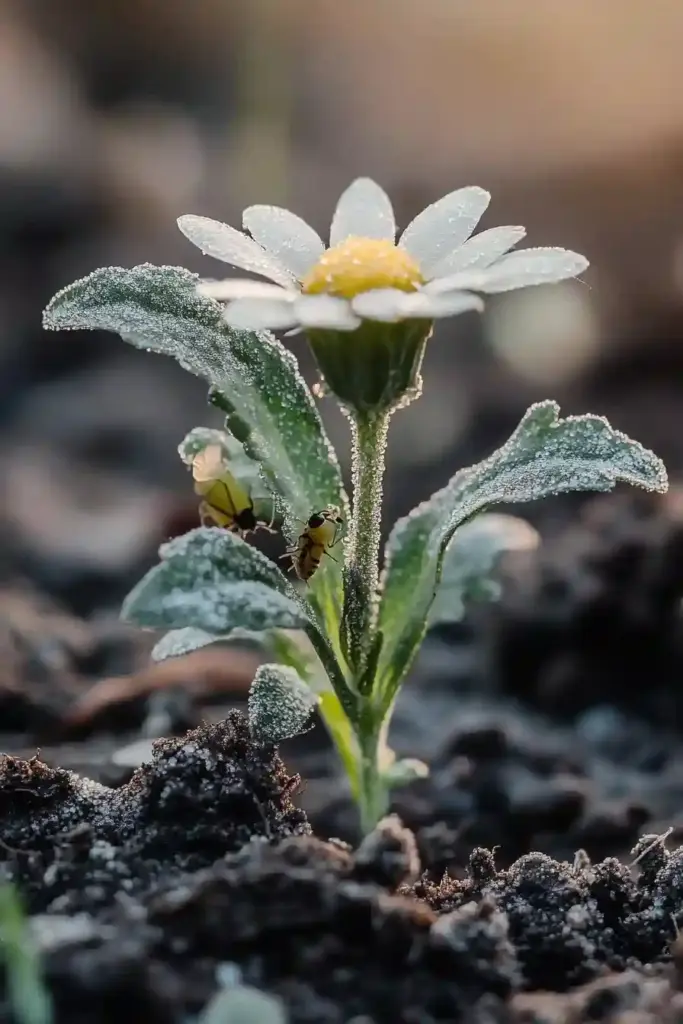
If you’re working with nursery plants or dividing mature daisies, here’s what to do:
🪴 Planting Instructions:
- Location: Full sun, with room for air circulation
- Spacing: Leave 12 to 18 inches between plants
- Depth: Plant at the same depth as they were in the container
- Water well after planting to help roots establish
🍂 Fall Planting Tip:
Planting in early fall? Add mulch around the base to insulate roots and prevent winter damage. This is especially helpful if you’re dividing mature plants or planting in colder zones.
✂️ How to Prune Daisies for Healthier, Longer-Lasting Blooms
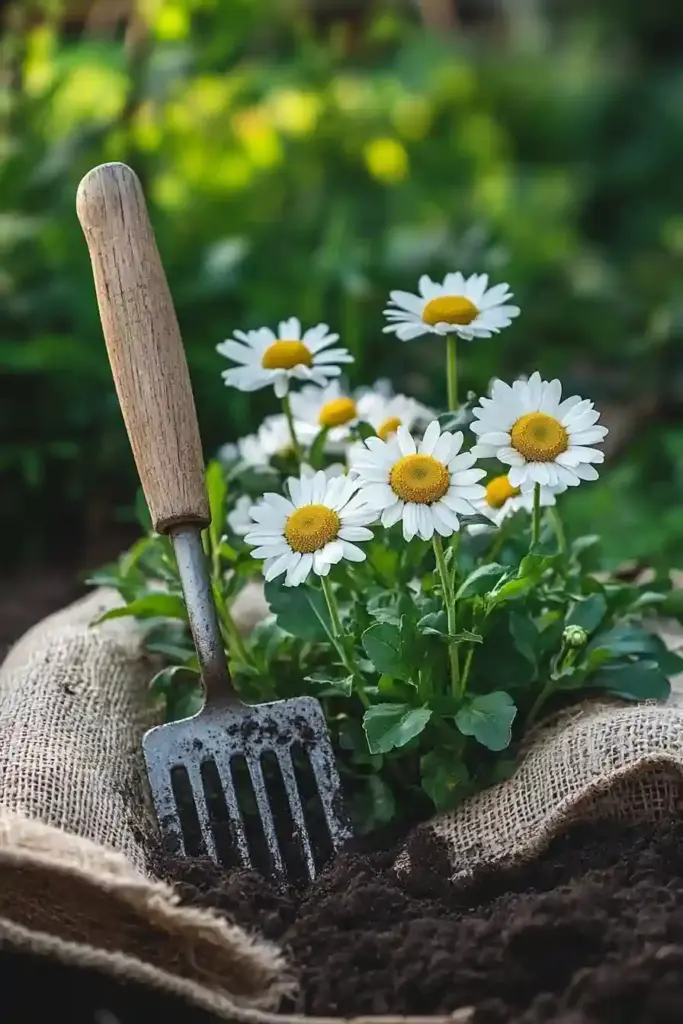
One of the reasons gardeners love daisies? They keep on blooming — especially with a little help. Regular pruning and deadheading not only improve appearance but also encourage fresh flowers and keep the plant strong.
Let’s look at how to do it right.
🪻 Deadheading: The Key to Continuous Blooms
Deadheading is the simple act of removing faded or spent blooms — and daisies thrive on it.
Here’s how:
- Use clean garden scissors or your fingers
- Snip the stem just above a leaf node or side bud
- Repeat regularly during the blooming season
🌼 Why it matters: Deadheading prevents the plant from wasting energy on seed production and redirects it to new growth and flowers.
🌿 Seasonal Pruning: Trim for Shape and Strength
Daisies don’t need a heavy pruning routine, but a few seasonal trims can go a long way.
In mid-summer:
- Lightly pinch back overgrown stems to keep plants tidy
- This helps shape the plant and prevents flopping
In late fall:
- Cut back wilted or weak-stemmed daisies to 2–3 inches above the ground
- For hardier varieties, you can leave the stems intact for winter interest and wildlife shelter
🛑 Avoid cutting back in early fall if your variety is still blooming — like Montauk daisies, which flower late into the season.
🌸 How to Propagate and Divide Daisies: More Blooms, More Beauty
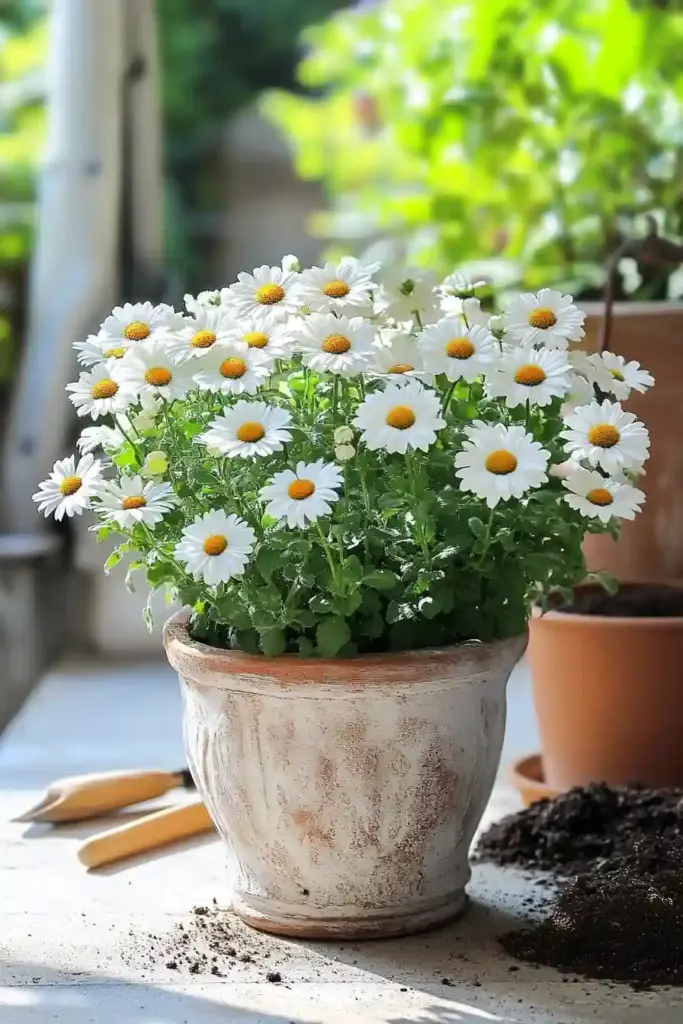
One of the best things about daisies? They’re generous growers. Once established, you can multiply them easily by dividing mature clumps — perfect for expanding your garden or sharing with friends and neighbors.
🌼 When to Divide Daisies
Daisies benefit from division every few years — usually after their third growing season. If you notice the center of the clump dying out or blooms becoming sparse, it’s time to divide.
Best times to divide:
- Late summer (after blooming finishes)
- Early fall (before the first frost)
- Early spring (before new growth starts)
🌱 How to Divide Daisies Step-by-Step
- Choose a healthy, mature plant (not newly planted).
- Cut the flowers back to about 6 inches if blooming.
- Dig up the entire root clump carefully with a garden fork or spade.
- Gently separate the roots into 2–4 sections — each with healthy shoots and roots.
- Replant immediately in well-drained soil, spacing sections about 12–18 inches apart.
- Water thoroughly to help roots settle.
🌿 Pro Tip: Add compost to the new planting holes for an extra nutrient boost!
🪴 How to Grow and Repot Daisies in Containers
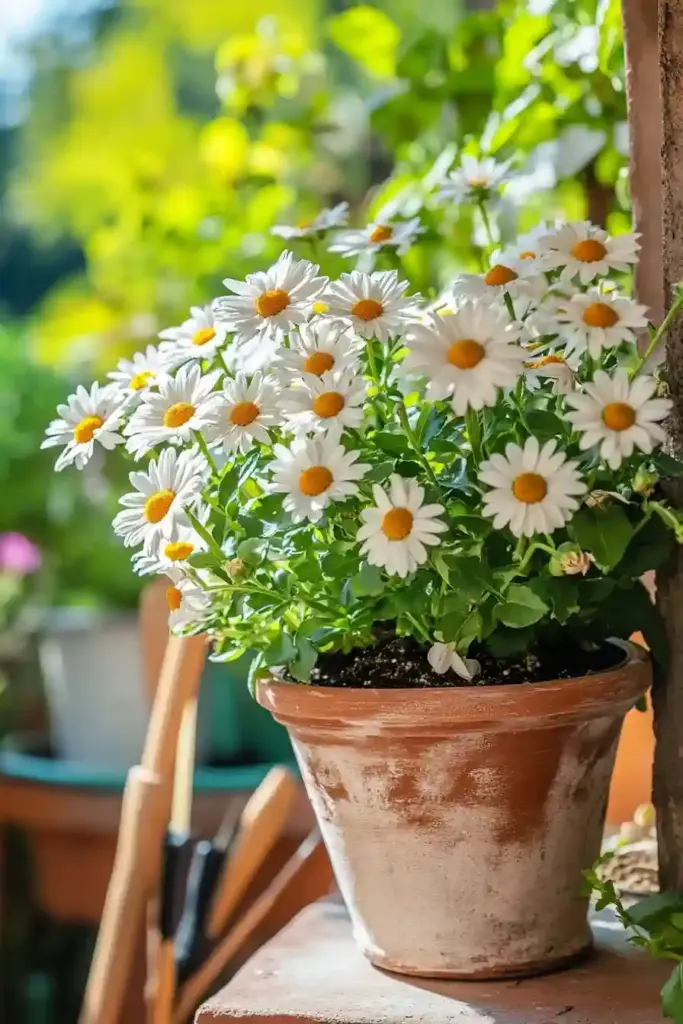
Don’t have a garden bed? No problem — daisies thrive in containers too! Whether on a balcony, porch, or sunny windowsill, daisies can add cheerful color to your outdoor space when potted properly.
Here’s how to set them up for success in pots.
🌞 Choosing the Right Container
- Size: Start with a pot that’s 2 inches wider than the plant’s root ball
- Material: Terra cotta, ceramic, or plastic all work — just make sure it has drainage holes
- Tip: Avoid overly large pots too soon, as they can hold too much moisture and lead to root rot
🪴 Best Potting Mix for Daisies
- Use well-draining potting soil, preferably one mixed with perlite or sand
- Avoid dense, moisture-retentive soils that stay soggy
- You can also mix in compost or a slow-release fertilizer at planting time
🔁 When and How to Repot Daisies
As your daisies grow, their roots will eventually outgrow their container — and they’ll let you know it’s time for a new pot.
Signs it’s time to repot:
- Roots are circling the pot or growing out of the drainage holes
- Water runs straight through the soil
- Slower growth or fewer blooms
How to repot:
- Gently remove the plant from its current pot
- Loosen the roots (trim if needed)
- Replant in a new container that’s 1–2 inches larger
- Water well and place in full sun
🌼 Best time to repot: Early spring, just before active growth begins
🐛 Common Problems With Daisies (And How to Keep Them Healthy)
Daisies are tough, but like all plants, they’re not completely immune to a few garden challenges. The good news? Most issues are easy to prevent or treat with a little attention and care.
Here’s what to look out for — and how to keep your daisies in top shape.
🐌 Pests: Who’s Munching on Your Daisies?
While daisies aren’t a top pick for many pests, a few garden grazers might still swing by:
- Deer & rabbits: Known to nibble on tender stems and leaves. Use deterrent sprays or fencing if needed.
- Aphids: These tiny bugs suck sap from new growth. Rinse off with a strong spray of water or treat with neem oil.
- Leafhoppers & thrips: May cause spotting or distort new leaves — use insecticidal soap for mild infestations.
🍄 Diseases: Prevent Moisture-Related Trouble
Most daisy diseases come down to one thing: too much moisture. Here’s what to watch for:
⚠️ Common fungal issues:
- Powdery mildew: Appears as a gray or white coating on leaves — usually due to poor air circulation and high humidity.
- Leaf spot (Alternaria, Septoria): Shows up as brown or black spots, especially during wet weather.
✅ Prevention & Treatment:
- Water at the base — not overhead — to keep leaves dry
- Space plants properly for airflow
- Remove affected leaves and apply a fungicide if needed (look for sulfur or myclobutanil-based options)
⚠️ Root Rot and Overwatering
If your daisies suddenly wilt or turn yellow, check the roots. Mushy, brown roots = trouble.
- Solution: Improve drainage, cut back on watering, and consider repotting if in containers
🌟 Final Thoughts: Grow Happy With Daisies
Whether you’re planting a few cheerful Shasta daisies in your garden or filling your patio with colorful gerberas, one thing is clear — daisies bring joy with minimal effort. By giving them the right sunlight, soil, and just a touch of maintenance, these bright blooms will reward you season after season.
From starting seeds to dividing mature clumps, learning how to grow and care for daisies means more than just mastering a few steps — it’s about creating a garden that feels alive, happy, and full of charm.
So grab your gloves, pick your favorite variety, and start planting. Your perfect patch of daisies is just a few steps away. 🌿💛

